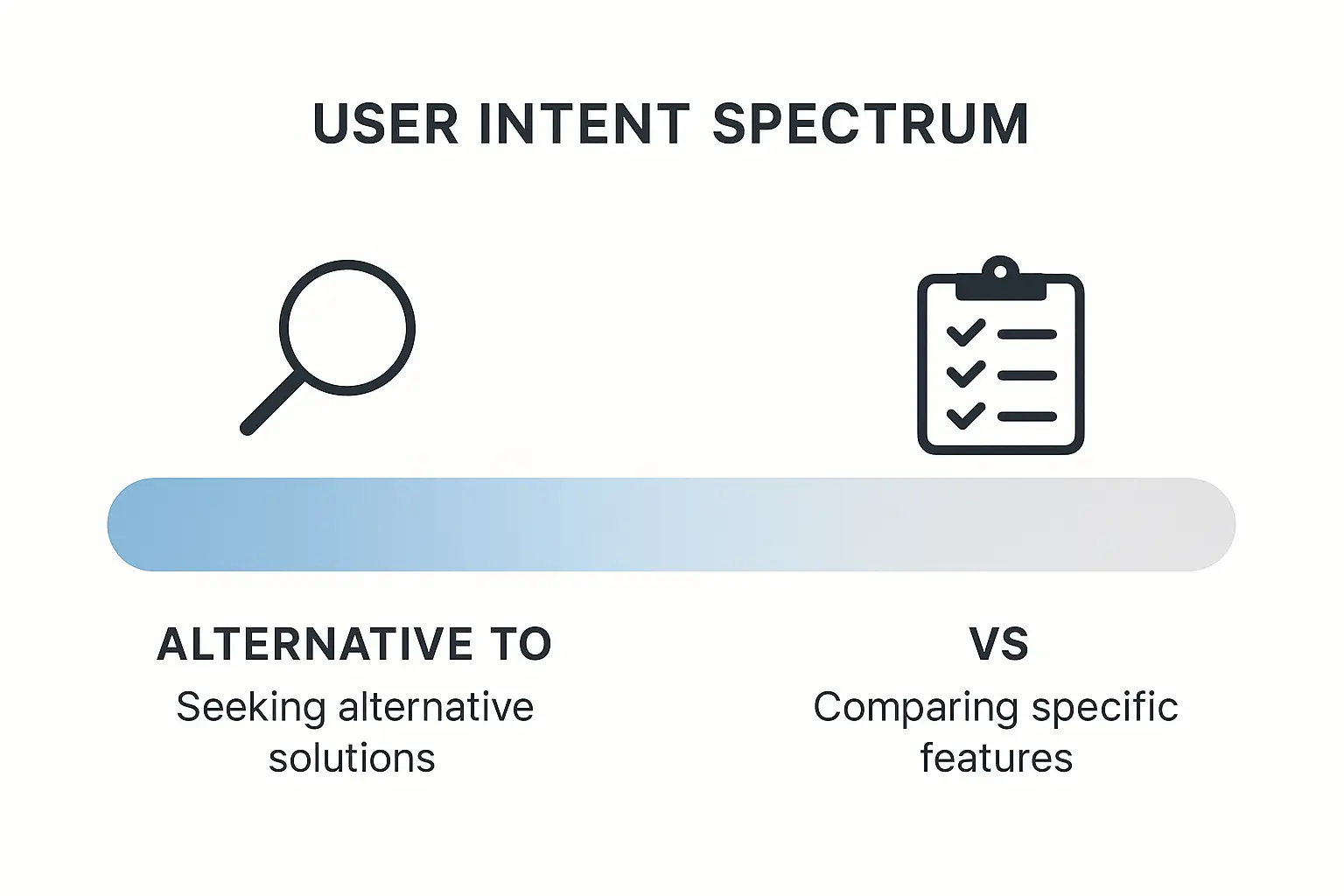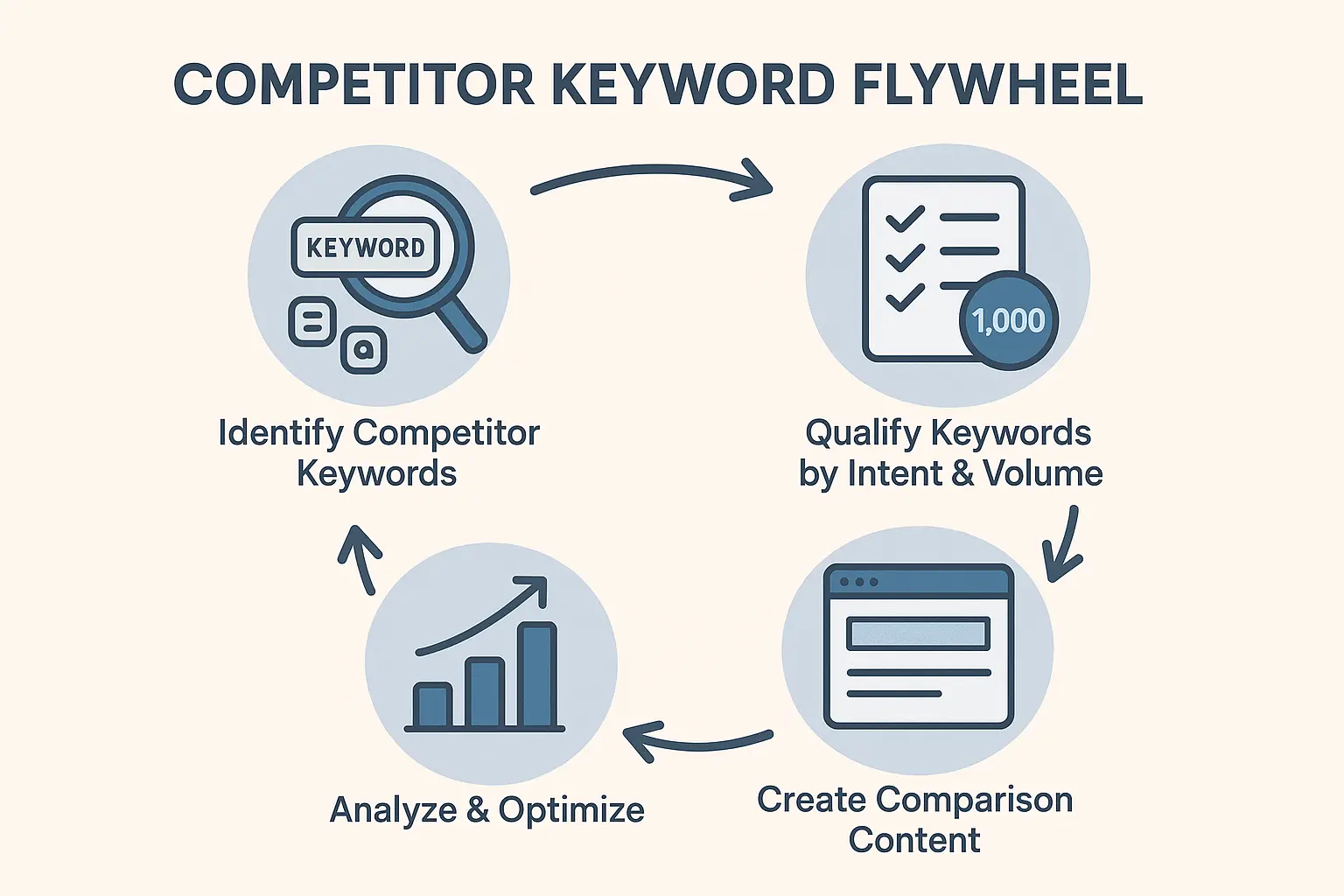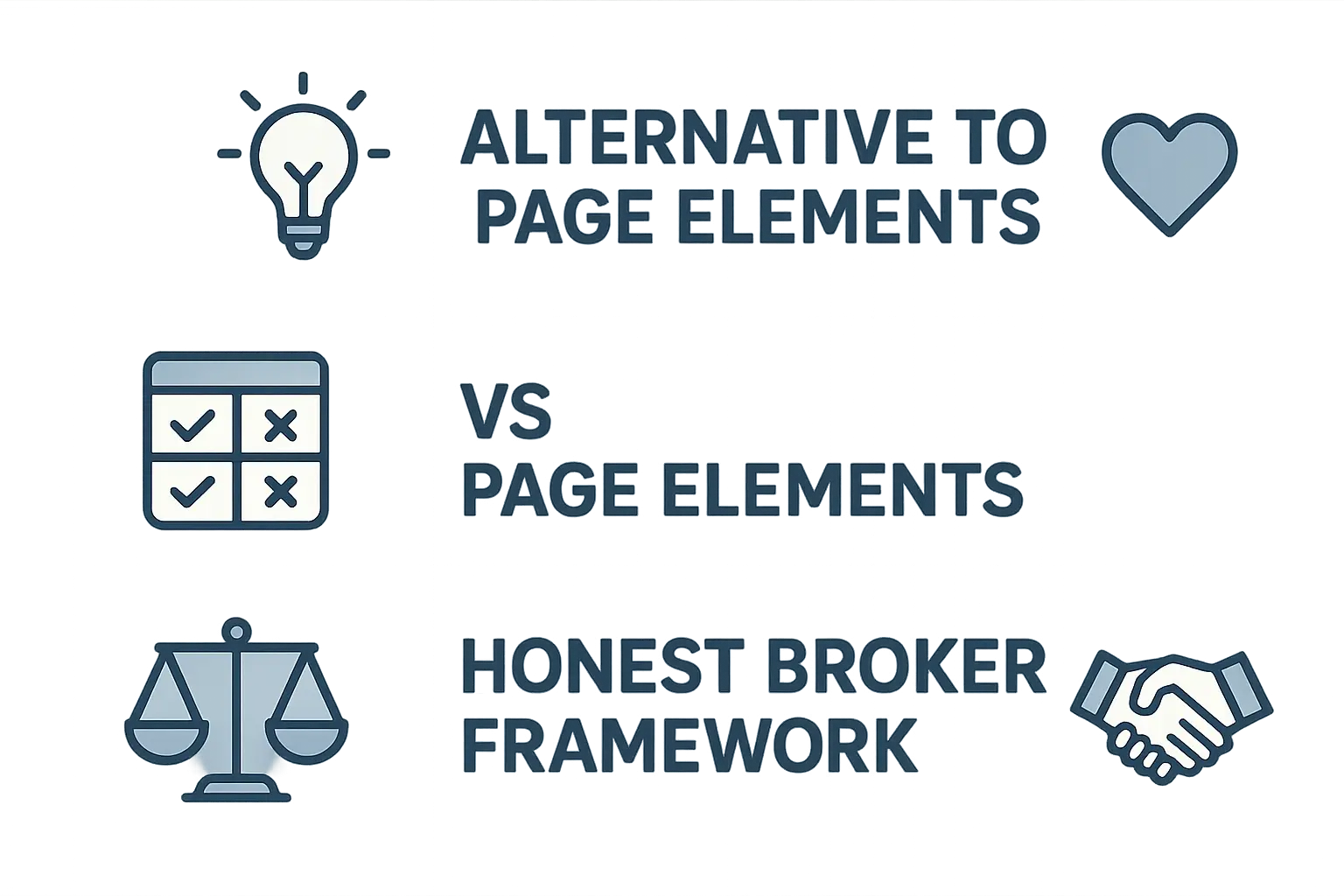Imagine your client’s ideal customer. They’re online, credit card within reach, ready to solve a problem. But they aren’t typing in broad, general terms like “project management software.” They’re well past that initial discovery phase.
Instead, their Google search looks like this:
- asana vs monday
- best mailchimp alternative
- hubspot competitor for small business
This is the digital moment of truth. They know the major players, understand their problem, and are actively making a final decision. If your client isn’t showing up in these search results, they aren’t just missing out on traffic—they’re absent from the final conversation.
This is the world of competitor-aware keywords, a frequently overlooked goldmine of high-intent traffic. By strategically targeting these terms, you can insert your client’s brand directly into the decision-making process, positioning them as the perfect solution just when a buyer is ready to choose.
Understanding the “Consideration Stage” Searcher
In any customer journey, there’s a critical middle phase. A user has identified their problem (e.g., “my team is disorganized”) and researched the landscape of solutions (e.g., “project management tools”). Now, they enter the consideration stage, where they weigh their options.
Research from Google shows that today’s consumers are voracious researchers, with some engaging with over 500 digital touchpoints before making a decision. They compare features, read reviews, and look for social proof, making their searches specific, targeted, and incredibly valuable.
Why are these keywords so powerful?
-
High Intent: Searches for “alternatives” often signal dissatisfaction with a current solution or market leader, while “vs” searches indicate a user is in the final stages of comparison. These people are not just browsing; they are looking to buy.
-
Qualified Audience: You’re not educating someone from scratch. They already understand the problem your client solves. You just need to convince them that your client solves it better.
-
Strategic Positioning: You get to control the narrative. By creating the comparison page, you frame the debate, highlighting your client’s strengths against a competitor’s known weaknesses.
Ignoring these keywords is like letting your competitor have a one-on-one conversation with your best prospect, with no one there to represent your client.
How to Build Content That Wins the Comparison Battle
Creating content for these keywords isn’t about aggressive attacks or misleading claims. It’s about becoming a trusted resource. Your goal is to create a page so genuinely helpful that it leaves the reader thinking, “Wow, they were really fair, and it seems like their solution is the best fit for me.”
There are two primary types of pages to build:
1. The ‘Alternative to’ Page
This page is perfect for capturing users who are actively looking to switch from an industry leader or a specific competitor. They might be frustrated with price, features, or customer service.
The Strategy: Create a list-style article titled something like “The 7 Best [Competitor Name] Alternatives for [Use Case].”
-
Position Your Client at #1: Introduce your client’s product as the top alternative, clearly explaining why it’s a better choice by focusing on the likely pain points of someone leaving the competitor.
-
Be Honest and Comprehensive: Include other genuine alternatives in the list. This builds immense trust. If you only list your client, the page looks like a biased ad. A real, balanced overview establishes your client’s brand as an honest, knowledgeable expert.
-
Address the “Why”: Open the article by acknowledging the reasons someone might be searching for an alternative. “Are you looking for a [Competitor] alternative with better customer support and a more intuitive interface? You’re in the right place.”
2. The ‘Versus’ Page
This is a direct head-to-head comparison. It’s your chance to put your client side-by-side with a competitor and showcase their unique advantages.
The Strategy: Create a dedicated landing page that feels like an objective review.
-
Use a Comparison Table: Visuals are key. A simple table comparing features, pricing, and key benefits is an incredibly effective tool for this page, allowing users to quickly scan and see the differences.
-
Acknowledge Their Strengths, Highlight Your Own: Start by being fair. “Competitor X is a great tool for large enterprises that need…” This disarms the reader. Then, pivot: “…however, for small, agile teams that prioritize speed and ease of use, [Your Client’s Product] is the clear winner because…”
-
Focus on Outcomes, Not Just Features: Don’t just list what your client’s product has; explain what it does for the user. Instead of “API Access,” say “Integrates Seamlessly with Your Existing Tools.”
Here’s a simple visual structure for a high-converting ‘vs’ page that guides the user toward a clear conclusion.

The key to both page types is empathy. Understand the searcher’s goal—to make the best possible choice with confidence—and build your page to help them achieve it. Scaling this type of thoughtful content creation for numerous clients requires a streamlined process. That’s often why many agencies choose an SEO partner for agencies to handle the heavy lifting of research, writing, and optimization.
Beyond the Blog Post: An Omnichannel Approach
Capturing traffic from these keywords is a huge win, but the journey doesn’t have to end there. This high-intent audience is perfect for a multi-channel engagement strategy.
Think of your comparison page as the central hub.
-
Paid Retargeting: Anyone who visits your “Competitor X Alternative” page is a hot lead. Run highly targeted social media or search ads showing them case studies, testimonials, or special offers related to your client’s product.
-
Email Nurturing: Use a call-to-action on the page to offer a more detailed comparison guide or a free trial in exchange for their email, letting you continue the conversation in their inbox.
-
Sales Enablement: Your sales team can use these pages as tools. When a prospect mentions a competitor, the sales rep can send a link to the objective-looking comparison page, reinforcing their pitch with a trusted resource.
This integrated approach turns a single piece of SEO content into a powerful engine for growth, guiding users from initial comparison to final conversion.

Frequently Asked Questions (FAQ)
Q: Won’t creating pages about our competitors make them angry?
This is a common concern, but the approach is about education, not aggression. As long as your comparisons are factual, fair, and focused on helping the user, you are well within ethical and professional boundaries. Think of it as contributing to a more transparent marketplace. The goal isn’t to tear down a competitor; it’s to elevate your client by clearly articulating their value.
Q: What if my client is new and doesn’t have well-known direct competitors?
You can still use this strategy. Instead of targeting a specific brand, target a category of solution. For example, if your client has a new CRM, you could create pages for:
- “Salesforce alternatives for small businesses”
- “Best CRM to replace spreadsheets”
- “Hubspot vs. using a simple spreadsheet”
This positions your client against the status quo or the market leader, which is often the biggest competitor for any new product.
Q: How can a small agency implement this strategy at scale for multiple clients?
Starting small is key. Pick one or two high-value competitors for a single client and build out a test page. Once you prove the model, scaling it becomes the next challenge. This involves significant resources for research, content creation, and ongoing optimization. Many growing agencies find success by using white-label SEO services to execute these campaigns. This frees up their in-house team to focus on strategy and client relationships.
Q: Is this keyword strategy only for B2B/SaaS companies?
Not at all. It works across many industries:
- E-commerce: “Nike vs Adidas running shoes,” “Best alternative to the Instant Pot”
- Local Services: “Terminix vs Orkin for pest control,” “Alternatives to Yelp for finding plumbers”
- Finance: “Betterment vs Wealthfront for IRA,” “Best alternatives to QuickBooks”
Anywhere a customer has a choice to make, there’s an opportunity to create comparison content.
Start Listening to the Conversation
Your prospects are already talking about your client’s competitors. The only question is whether your client will be part of that conversation. By tuning into ‘vs’ and ‘alternative to’ keywords, you can move beyond chasing broad, low-intent traffic and start connecting with buyers who are ready to make a choice.
Start by doing a few simple Google searches. What comes up when you look for alternatives to your client’s biggest competitor? The answer might reveal your biggest untapped opportunity for growth.
Ready to explore more advanced strategies to drive meaningful results for your clients? See how we help agencies scale SEO and turn search insights into a competitive advantage.


